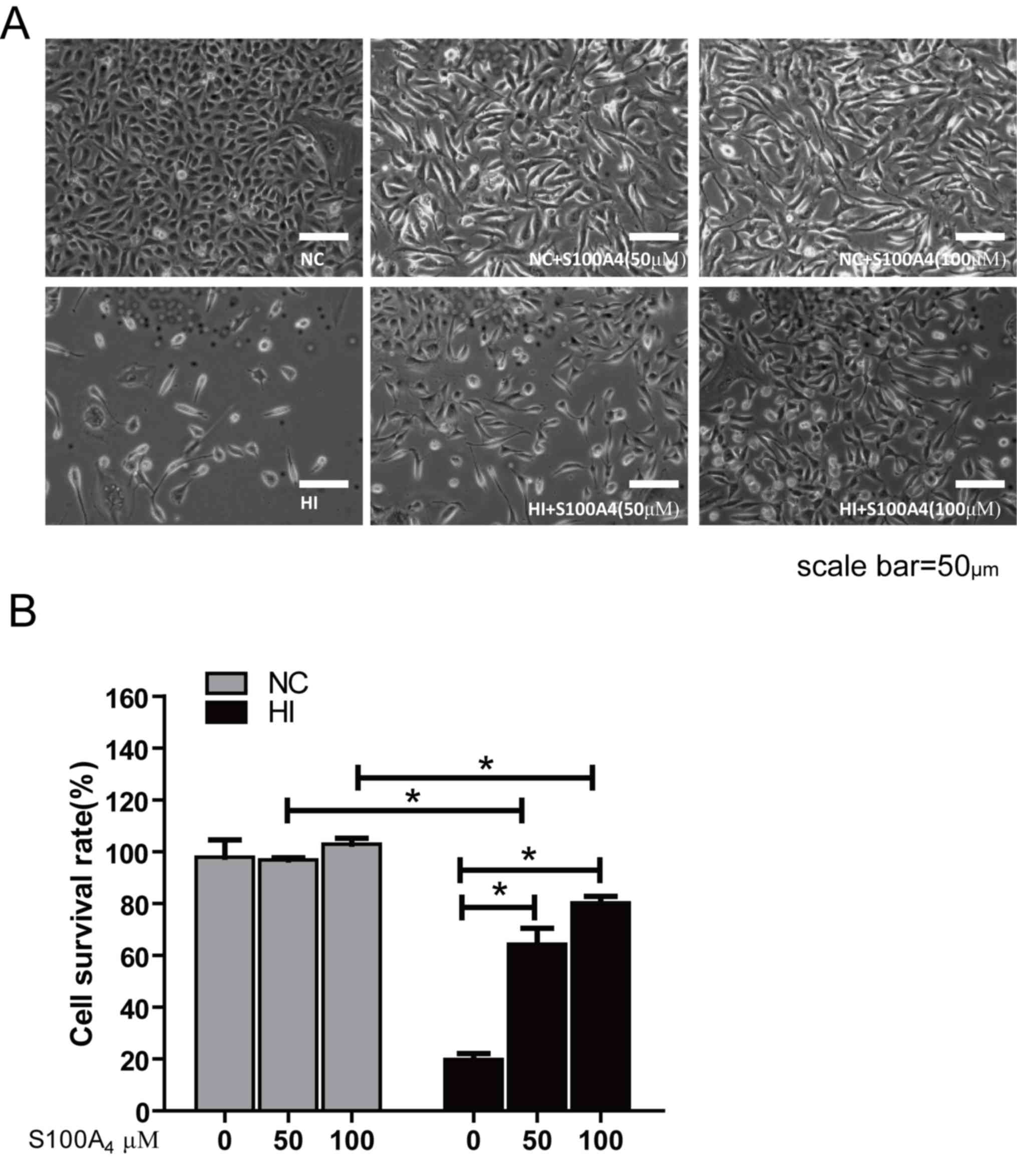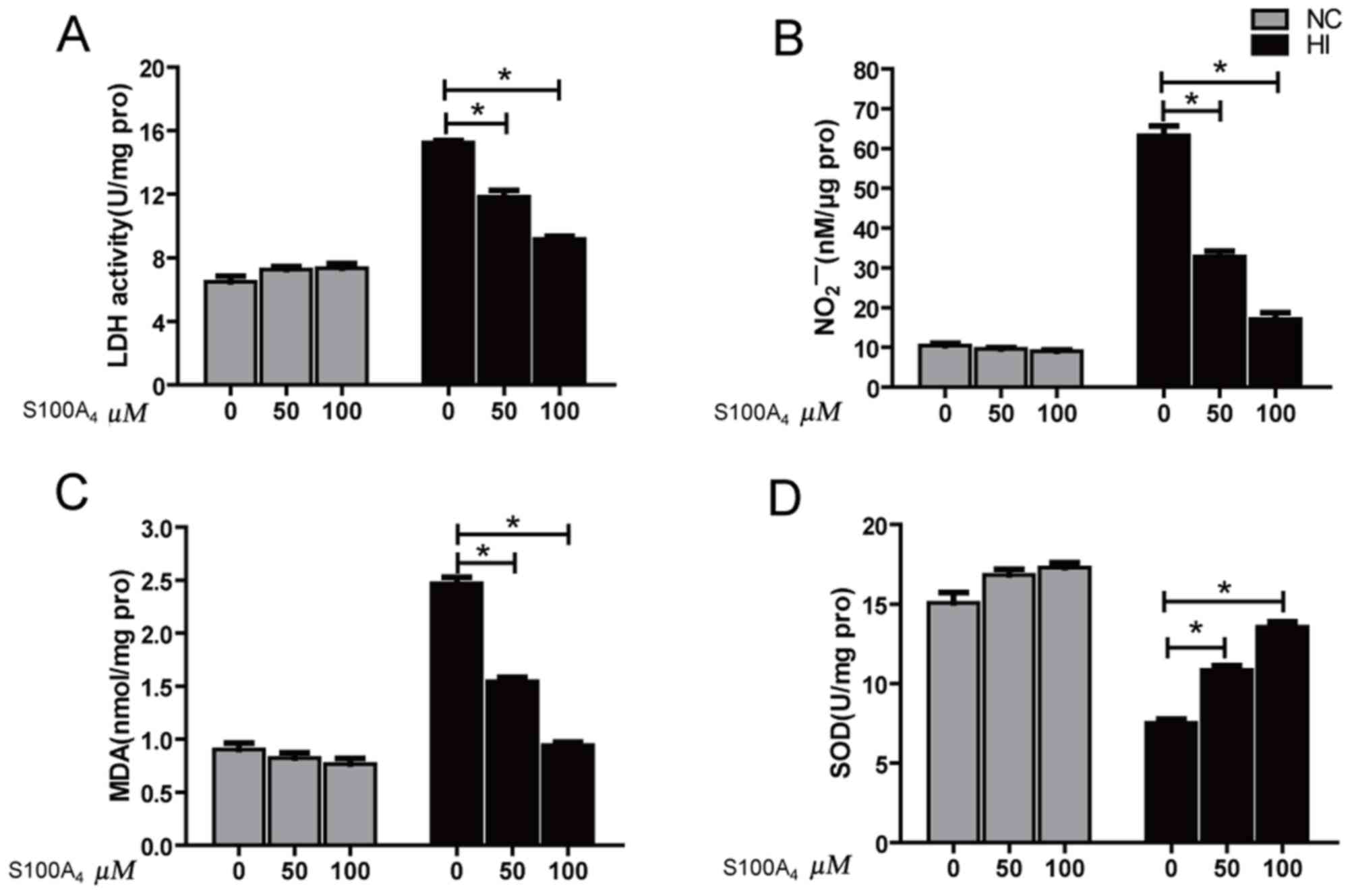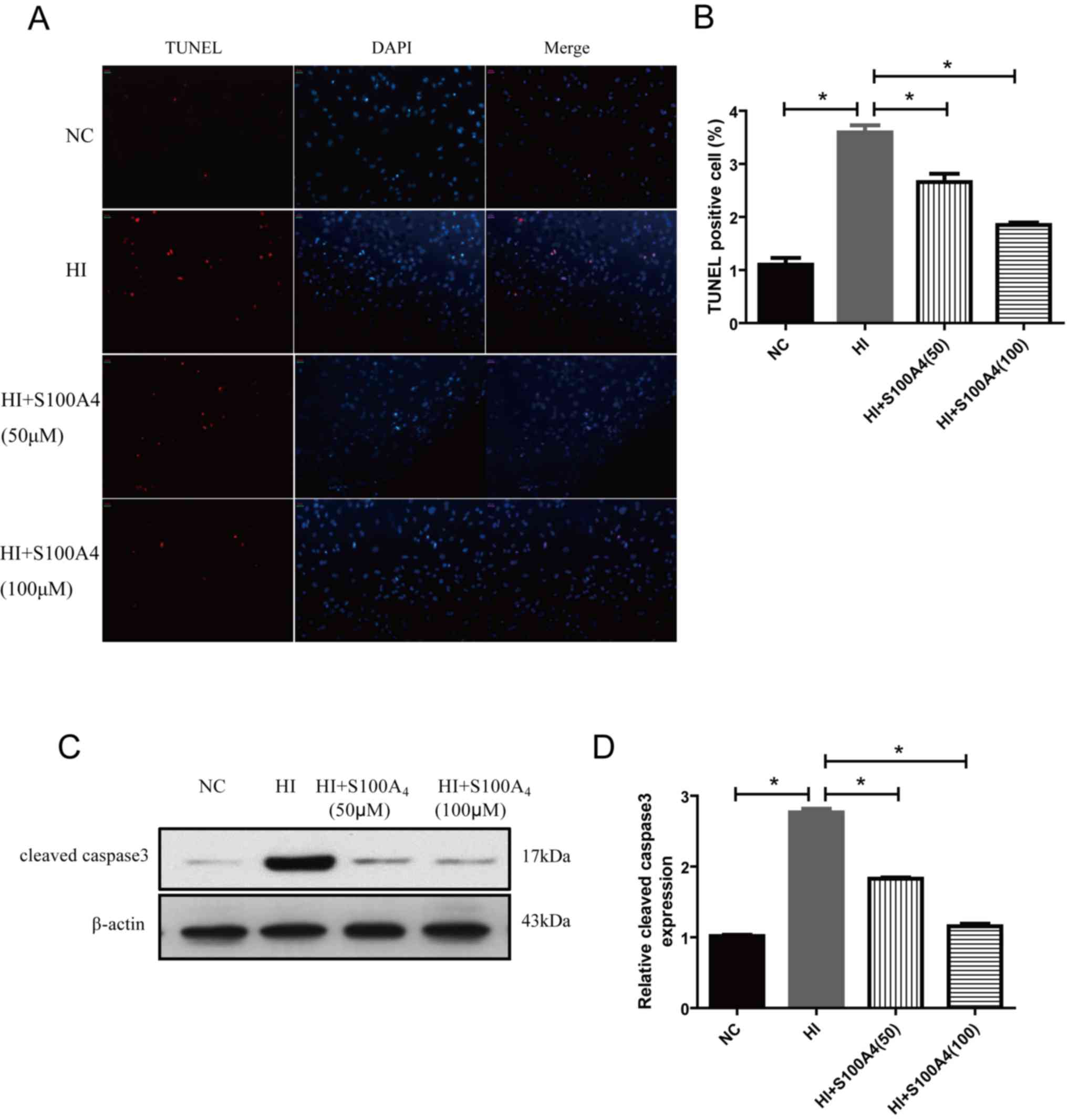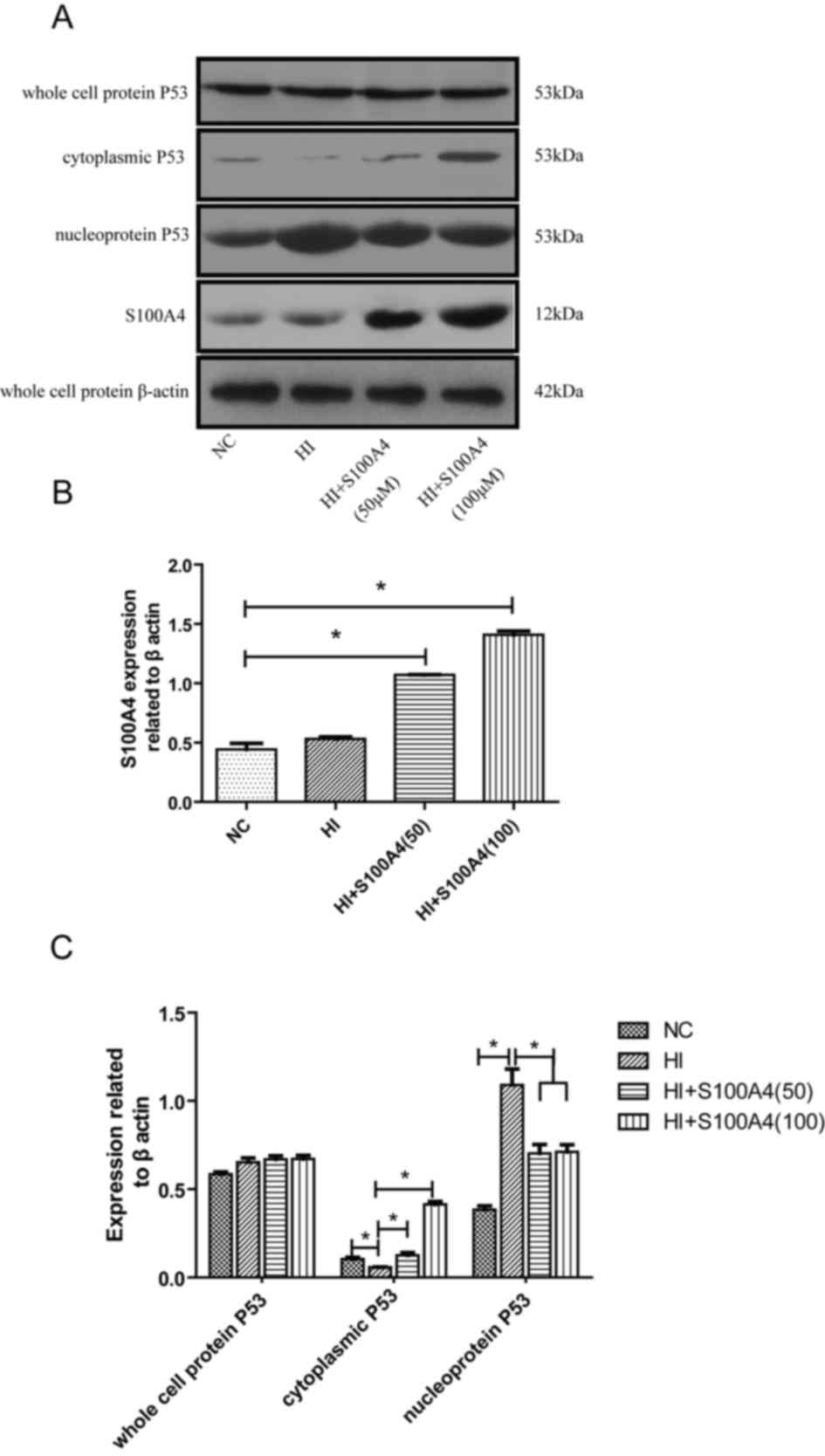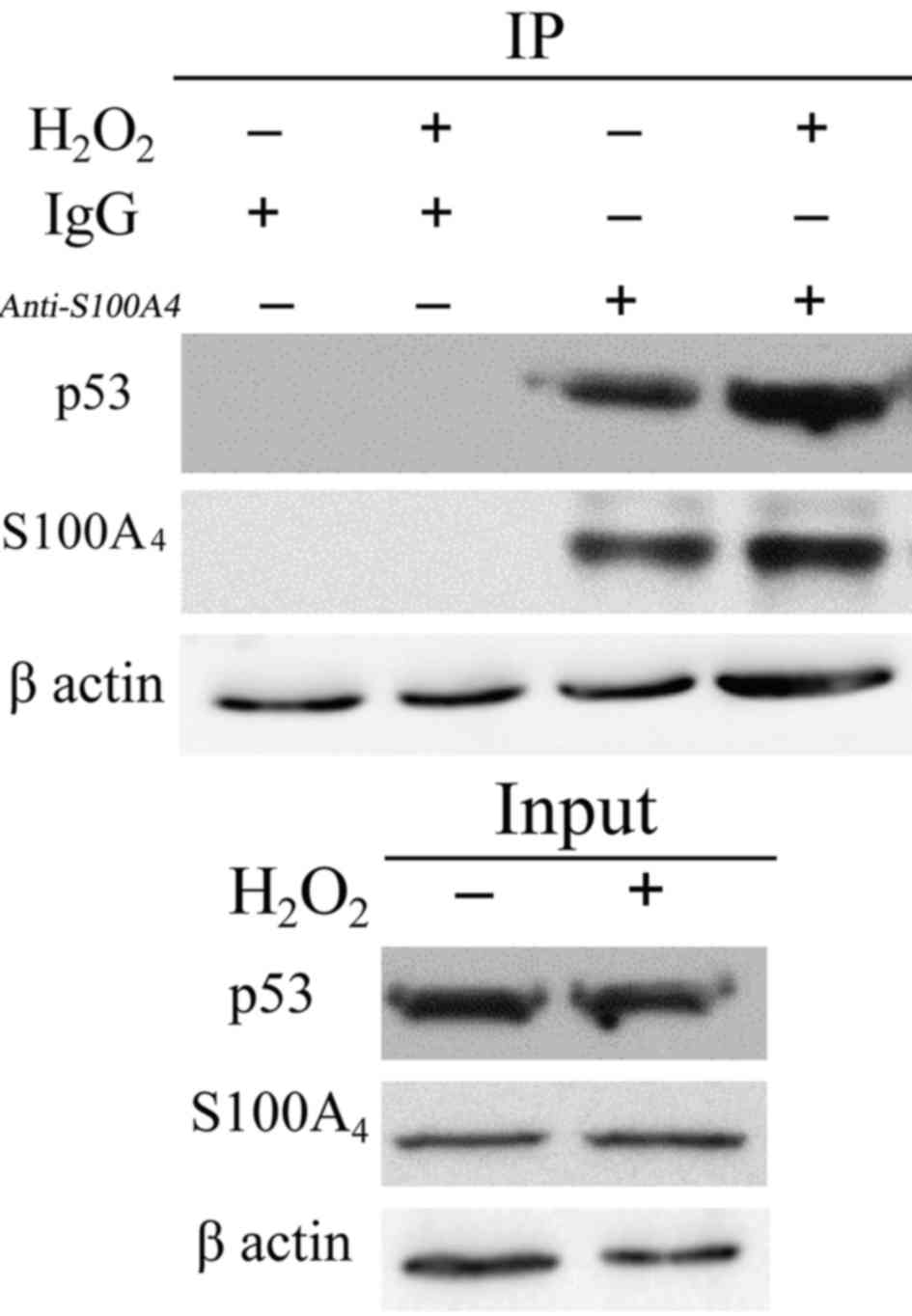|
1
|
Shanthi M, Tim A, Douglas B, Francesco B,
Jeremy L, Cecile M, Vladimir P, Leanne R, Vera Da Costa E Silva and
Gretchen S: Global status report on concommunicable diseases
2014[R]. Geneva: World Health Organization 9; 2014
|
|
2
|
World Health Organization, . Fact Sheet
no. 317. Geneva: WHO; 2011
|
|
3
|
Crimi E, Ignarro LJ and Napoli C:
Microcirculation and oxidative stress. Free Radi Res. 41:1364–1375.
2007. View Article : Google Scholar
|
|
4
|
Loscalzo J: Redox dysregulation in
vascular pathobiology. Free Radic Biol Med. 75 Suppl 1:S22014.
View Article : Google Scholar : PubMed/NCBI
|
|
5
|
Marchenko ND and Moll UM: Mitochondrial
death functions of p53. Mol Cell Oncol. 1:e9559952014. View Article : Google Scholar : PubMed/NCBI
|
|
6
|
Tarabykina S, Griffiths TR, Tulchinsky E,
Mellon JK, Bronstein IB and Kriajevska M: Metastasis-associated
protein S100A4: Spotlight on its role in cell migration. Curr
Cancer Drug Targets. 7:217–228. 2007. View Article : Google Scholar : PubMed/NCBI
|
|
7
|
Moroz OV, Antson AA, Murshudov GN,
Maitland NJ, Dodson GG, Wilson KS, Skibshøj I, Lukanidin EM and
Bronstein IB: The three-dimensional structure of human S100A12.
Acta Crystallogr D Biol Crystallogr. 57:20–29. 2001. View Article : Google Scholar : PubMed/NCBI
|
|
8
|
Ridinger K, Schäfer BW, Durussel I, Cox JA
and Heizmann CW: S100A13 biochemical characterization and
subcellular localization in different cell lines. J Biol Chem.
275:8686–8694. 2000. View Article : Google Scholar : PubMed/NCBI
|
|
9
|
Mazzuccheli L: Protein S100A4: Too long
overlooked by pathologists? Am J Pathol. 160:7–13. 2002. View Article : Google Scholar : PubMed/NCBI
|
|
10
|
Donato R: S100: A multigenic family of
calcium-modulated proteins of the EF-hand type with intracellular
and extracelluar functions roles. Int J Biochem Cell Biol.
33:637–668. 2001. View Article : Google Scholar : PubMed/NCBI
|
|
11
|
Garrett SC, Varney KM, Weber DJ and
Bresnick AR: S100A4, a mediator of metastasis. J Biol Chem.
281:677–680. 2006. View Article : Google Scholar : PubMed/NCBI
|
|
12
|
Ambartsumian N, Grigorian M and Lukanidin
E: Genetically modified mouse models to study the role of
metasasis-promoting S100A4(mts1) protein in metastatic mammary
cancer. J Dairy Res. 72:27–33. 2005. View Article : Google Scholar : PubMed/NCBI
|
|
13
|
Schmidt-Hansen B, Klingelhöfer J,
Grum-Schwensen B, Christensen A, Andresen S, Kruse C, Hansen T,
Ambartsumian N, Lukanidin E and Grigorian M: Functional
significance of metastasis-including S100A4(Mts1) in tumor-stroma
interplay. J Biol Chem. 279:24498–24504. 2004. View Article : Google Scholar : PubMed/NCBI
|
|
14
|
Orre LM, Panizza E, Kaminskyy VO, Vernet
E, Gräslund T, Zhivotovsky B and Lehtiö J: S100A4 interacts with
p53 in the nucleus and promotes p53 degradation. Oncogene.
32:5531–5540. 2013. View Article : Google Scholar : PubMed/NCBI
|
|
15
|
Wang XH, Chen SF, Jin HM and Hu RM:
Differential analyses of angiogenesis and expression of growth
factors in micro- and macrovascular endothelial cells of type 2
diabetic rats. Life Sci. 84:240–249. 2009. View Article : Google Scholar : PubMed/NCBI
|
|
16
|
Hao J, Shen W, Tian C, Liu Z, Ren J, Luo
C, Long J, Sharman E and Liu J: Mitochondrial nutrients improve
immune dysfunction in the type 2 diabetic Goto-Kakizaki rats. J
Cell Mol Med. 13:701–11. 2009. View Article : Google Scholar : PubMed/NCBI
|
|
17
|
Chesterman CN: Vascular endothelium,
haemostasis and thrombosis. Blood Rev. 2:88–94. 1988. View Article : Google Scholar : PubMed/NCBI
|
|
18
|
Tang X, Yang X, Peng Y and Lin J:
Protective effects of lycopene against
H2O2-induced oxidative injury and apoptosis
in human endothelial cells. Cardiovasc Drugs Ther. 23:439–448.
2009. View Article : Google Scholar : PubMed/NCBI
|
|
19
|
Kadl A and Leitinger N: The role of
endothelial cells in the resolution of acute inflammation. Antioxid
Redox Signal. 7:1744–1754. 2005. View Article : Google Scholar : PubMed/NCBI
|
|
20
|
Pober JS and Sessa WC: Evolving functions
of endothelial cells in inflammation. Nat Rev Immunol. 7:803–815.
2007. View
Article : Google Scholar : PubMed/NCBI
|
|
21
|
Ramagopal UA, Dulyaninova NG, Varney KM,
Wilder PT, Nallamsetty S, Brenowitz M, Weber DJ, Almo SC and
Bresnick AR: Structure of the S100A4/myosin-IIA complex. BMC Struct
Biol. 20:13–31. 2013.
|
|
22
|
Toya SP and Malik AB: Role of endothelial
injury in disease mechanisms and contribution of progenitor cells
in mediating endothelial repair. Immunobiolog. 217:569–580. 2012.
View Article : Google Scholar
|
|
23
|
Boye K and Maelandsmo GM: S100A4 and
metastasis: A small actor playing many roles. Am J Pathol.
176:528–535. 2010. View Article : Google Scholar : PubMed/NCBI
|
|
24
|
Marenholz I, Heizmann CW and Fritz G: S100
proteins in mouse and man: From evolution to function and pathology
(including an update of the nomenclature). Biochem Biophys Res
Commun. 322:1111–1122. 2004. View Article : Google Scholar : PubMed/NCBI
|
|
25
|
Santamaria-Kisiel L, Rintala-Dempsey AC
and Shaw GS: Calcium-dependent and -independent interactions of the
S100 protein family. Biochem. 396:201–214. 2006. View Article : Google Scholar
|
|
26
|
Schneider M, Kostin S, Strøm CC, Aplin M,
Lyngbaek S, Theilade J, Grigorian M, Andersen CB, Lukanidin E,
Hansen Lerche J and Sheikh SP: S100A4 is regulated in injured
myocardium and promotes growth and survival of cardiac myocytes.
Cardiovasc Res. 75:40–50. 2007. View Article : Google Scholar : PubMed/NCBI
|
|
27
|
Chaabane C, Otsuka F, Virmani R and
Bochaton-Piallat ML: Biological responses in stented arteries.
Cardiovasc Res. 99:353–563. 2013. View Article : Google Scholar : PubMed/NCBI
|
|
28
|
Nowak JZ: Oxidative stress,
polyunsaturated fatty acids-derived oxidation products and
bisretinoids as potential inducers of CNS diseases: Focus on
age-related macular degeneration. Pharmacol Rep. 65:288–304. 2013.
View Article : Google Scholar : PubMed/NCBI
|
|
29
|
Schmidt-Hansen B, Ornås D, Grigorian M,
Klingelhöfer J, Tulchinsky E, Lukanidin E and Ambartsumian N:
Extracellular S100A4(mts1) stimulates invasive growth of mouse
endothelial cells and modulates MMP-13 matrix metalloproteinase
activity. Oncogene. 23:5487–5495. 2004. View Article : Google Scholar : PubMed/NCBI
|
|
30
|
Ambartsumian N, Klingelhöfer J, Grigorian
M, Christensen C, Kriajevska M, Tulchinsky E, Georgiev G, Berezin
V, Bock E, Rygaard J, et al: The metastasis associated Mts1(S100A4)
protein could act as an angiogenic factor. Oncogene. 20:4685–4695.
2001. View Article : Google Scholar : PubMed/NCBI
|
|
31
|
Semov A, Moreno MJ, Onichtchenko A,
Abulrob A, Ball M, Ekiel I, Pietrzynski G, Stanimirovic D and
Alakhov V: Metastasis-associated protein S100A4 induces
angiogenesis through interaction with Annexin II and accelerated
plasmin formation. J Biol Chem. 280:20833–20841. 2005. View Article : Google Scholar : PubMed/NCBI
|
|
32
|
Sakamoto T, Repasky WT, Uchida K, Hirata A
and Hirata F: Modulation of cell death pathways to apoptosis and
necrosis of H2O2-treated rat thymocytes by
lipocortin I. Biochem Biophys Res Comunun. 220:643–647. 1996.
View Article : Google Scholar
|
|
33
|
Toborek M, Lee YW, Garrido R, Kaiser S and
Hennig B: Unsaturated fatty acids selectively induce an
inflammatory environment in human endothelial cells. Am J Clin
Nutr. 75:119–125. 2002. View Article : Google Scholar : PubMed/NCBI
|
|
34
|
Mazière C, Conte MA, Degonville J, Ali D
and Mazière JC: Cellular enrichment with polyunsaturated fatty
acids induces an oxidative stress and activates the transcription
factors AP1 and NFkappaB. Biochem Biophys Res Commun. 265:116–122.
1999. View Article : Google Scholar : PubMed/NCBI
|
|
35
|
Alexander-North LS, North JA, Kiminyo KP,
Buettner GR and Spector AA: Polyunsaturated fatty acids increase
lipid radical formation induced by oxidant stress in endothelial
cells. J Lipid Res. 35:1773–1785. 1994.PubMed/NCBI
|
|
36
|
Nowak JZ: Oxidative stress,
polyunsaturated fatty acids-derived oxidation products and
bisretinoids as potential inducers of CNS diseases: Focus on
age-related macular degeneration. Pharmacol Rep. 65:288–304. 2013.
View Article : Google Scholar : PubMed/NCBI
|
|
37
|
Takeda N and Manabe I: Cellular interplay
between cardiomyocytes and nonmyocytes in cardiac remodeling. Int J
Inflam. 2011:5352412011. View Article : Google Scholar : PubMed/NCBI
|
|
38
|
Raij L: Hypertension, endothelium, and
cardiovascular risk factors. Am J Med. 90 Supple 2A:13S–18S. 1991.
View Article : Google Scholar : PubMed/NCBI
|
|
39
|
Smith EJ and Rothman MT: Antiproliferative
coatings for the treatment of coronary heart disease: What are the
targets and which are the tools? J Interv Cardiol. 16:475–483.
2003. View Article : Google Scholar : PubMed/NCBI
|
|
40
|
Onat D, Brillon D, Colombo PC and Schmidt
AM: Human vascular endothelial cells: A model system for studying
vascular inflammation in diabetes and atherosclerosis. Curr Diab
Rep. 11:193–202. 2011. View Article : Google Scholar : PubMed/NCBI
|
|
41
|
Parnell E, Smith BO, Palmer TM, Terrin A,
Zaccolo M and Yarwood SJ: Regulation of the inflammatory response
of vascular endothelial cells by EPAC1. Br J Pharmacol.
166:434–446. 2012. View Article : Google Scholar : PubMed/NCBI
|
|
42
|
Ma S, Yao S, Tian H, Jiao P, Yang N, Zhu P
and Qin S: Pigment epithelium-derived factor alleviates endothelial
injury by inhibiting Wnt/β-catenin pathway. Lipids Health Dis.
16:312017. View Article : Google Scholar : PubMed/NCBI
|
|
43
|
Yonish-Rouach E, Grunwald D, Wilder S,
Kimchi A, May E, Lawrence JJ, May P and Oren M: p53-mediated cell
death: Relationship to cell cycle control. Mol Cell Biol.
13:1415–1423. 1993. View Article : Google Scholar : PubMed/NCBI
|
|
44
|
Mueller A, Schäfer BW, Ferrai S, Weibel M,
Makek M, Höchli M and Heizmann CW: The calcium-binding protein
S100A2 interact with p53 and modulates its transcriptional
activity. J Biol Chem. 280:29186–29193. 2005. View Article : Google Scholar : PubMed/NCBI
|
|
45
|
Ma JQ, Ding J, Zhang L and Liu CM: Ursolic
acid protects mouse liver against CCl4-induced oxidative stress and
inflammation by the MAPK/NF-κB pathway. Environ Toxicol Pharmacol.
37:975–983. 2014. View Article : Google Scholar : PubMed/NCBI
|
|
46
|
Tilstra JS, Robinson AR, Wang J, Gregg SQ,
Clauson CL, Reay DP, Nasto LA, St Croix CM, Usas A, Vo N, et al:
NF-κB inhibition delays DNA damage-induced senescence and aging in
mice. J Clin Invest. 122:2601–2612. 2012. View Article : Google Scholar : PubMed/NCBI
|



